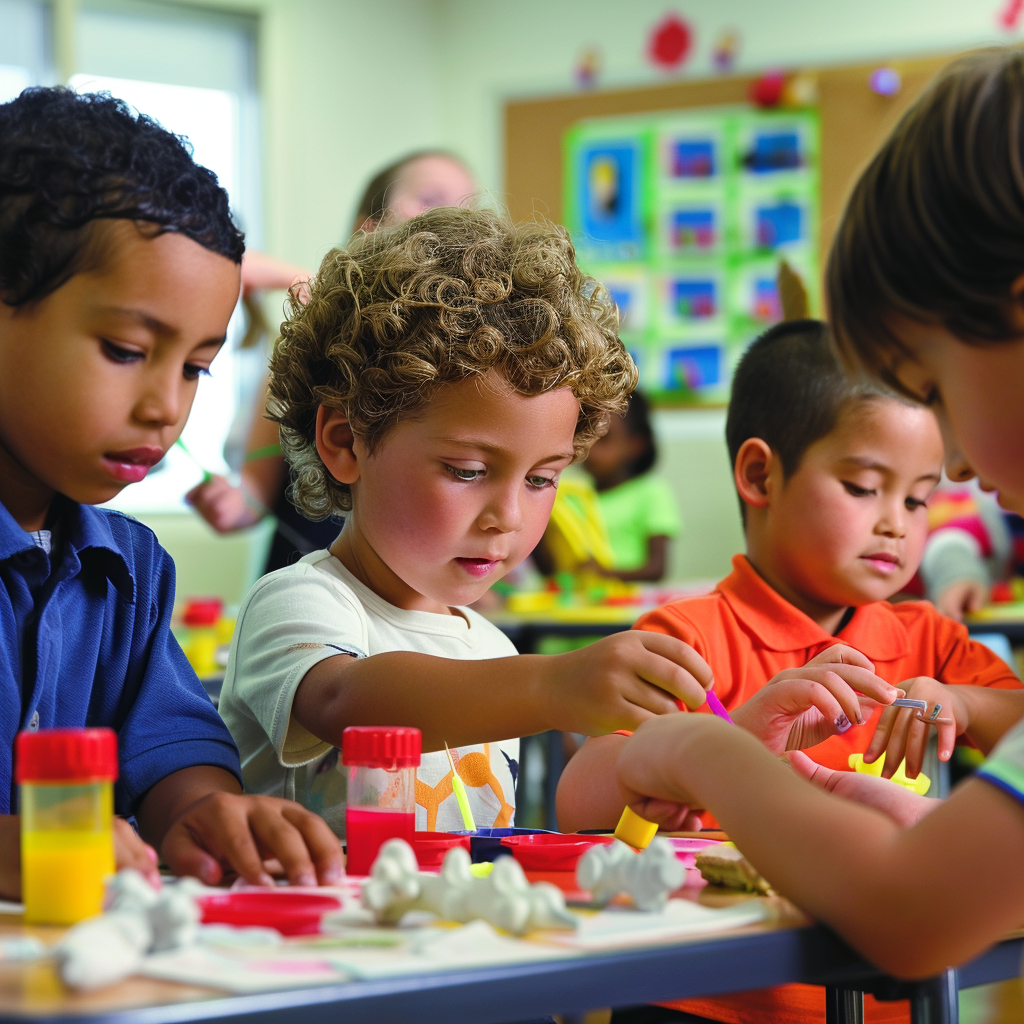Unlocking Potential: Project-Based Learning Strategies for Young Learners
Explore project-based learning strategies that ignite curiosity, critical skills, and real-world engagement for young learners—perfect for teachers.

Imagine a classroom where young students are not just passive recipients of information but active explorers, creators, and problem solvers. Project-Based Learning (PBL) transforms this vision into reality by making learning interactive, engaging, and deeply meaningful. This guide is designed to help you navigate the journey of implementing PBL in early education, offering practical strategies, inspiring examples, and solutions to common challenges.
Whether you’re new to PBL or looking to refine your approach, we will show you how to effectively integrate PBL into your teaching. Discover how this dynamic method can revolutionize your classroom and ignite a passion for learning in your students. Dive in and explore the transformative power of PBL, where every project is an opportunity for young minds to thrive and excel, making education a vibrant and exciting adventure for everyone involved.
Understanding Project-Based Learning
PBL is an instructional methodology that encourages students to learn and apply knowledge through engaging projects set around real-world challenges and problems. This approach shifts the traditional focus from passive absorption of information to active exploration, critical thinking, and collaborative problem-solving.
Central to PBL is inquiry-based learning, where students begin with a question or problem that drives their investigation. They gather information, think critically, and develop solutions, often culminating in a final project or presentation. Student choice is another key principle, allowing learners to take ownership of their projects by making decisions about the direction and nature of their work.
Enjoy science fiction? Check out my space books HERE on Amazon!
PBL also emphasizes real-world relevance, connecting academic content to practical applications. This not only makes learning more engaging for students but also helps them see the value and importance of their education in everyday life. By integrating these core principles, PBL fosters a deeper understanding of subject matter and develops essential life skills.
Benefits of Project-Based Learning for Younger Students
PBL offers numerous benefits for younger students, making it a powerful tool for early education. Here are some key advantages:
Enhanced Engagement: PBL increases student engagement by making learning interactive and enjoyable. When students are actively involved in hands-on projects, they are more likely to stay interested and motivated. This active participation helps them retain information better compared to traditional lecture-based learning.
Development of Critical Skills: PBL fosters the development of essential skills such as collaboration, communication, critical thinking, and problem-solving. Working on projects requires students to communicate their ideas, collaborate with peers, and think critically to overcome challenges. These skills are crucial for their overall development and future success.
Real-World Connections: PBL connects classroom learning to real-world issues and scenarios, making education more relevant and meaningful. By working on projects that address real-life problems, students understand the practical applications of their knowledge. This approach helps them see the value of their education and how it can be used to make a positive impact in the world.
Student Empowerment: PBL empowers students by giving them a sense of ownership over their learning. They have the freedom to choose topics that interest them and make decisions about their projects, fostering a sense of autonomy and responsibility.
Implementing PBL in Early Education
PBL in early education requires thoughtful planning and a gradual approach. Here are practical steps for teachers:
- Start Small: Begin with small, manageable projects to introduce PBL to your classroom. This allows both you and your students to become comfortable with the PBL process. Simple projects like a class garden or a recycling program can effectively demonstrate the principles of PBL.
- Choose Appropriate Projects: Select projects that are suitable for younger students' cognitive and emotional development. Projects should be engaging, hands-on, and relevant to their interests and experiences. For example, a project exploring local wildlife or community helpers can be both educational and captivating for young learners.
- Integrate Curriculum Standards: Ensure that your PBL activities align with educational standards and learning objectives. Design projects that incorporate key skills and knowledge areas, such as literacy, math, science, and social studies. This integration helps maintain a balanced curriculum while providing a richer learning experience.
- Provide Structure and Support: Younger students need clear guidance and support throughout their projects. Use structured timelines, checklists, and regular check-ins to help them stay on track. Scaffold their learning by breaking down tasks into manageable steps and providing resources and tools to assist their progress.
- Foster Collaboration: Encourage teamwork and peer learning by designing projects that require collaboration. Group activities help students develop social skills and learn from one another, enhancing the overall learning experience.
By following these steps, teachers can effectively implement PBL in early education, fostering a dynamic and engaging learning environment for young students.
Examples of Successful PBL Projects for Younger Students
PBL can seem daunting, but starting with tried-and-true examples can provide a roadmap for success. Here are some practical examples of PBL projects suitable for younger students:
- Science Projects
- Plant Growth Experiment: Students can explore the life cycle of plants by growing their own seeds. They can document growth stages, compare different types of plants, and learn about the conditions necessary for growth. This project integrates science with hands-on learning, fostering curiosity and observational skills.
- Recycling Initiative: Introduce concepts of sustainability and environmental stewardship through a classroom recycling program. Students can research the impact of waste, create recycling bins, and monitor the amount of waste reduced over time. This project teaches responsibility and the importance of taking care of the environment.
- Social Studies Projects
- Community Helpers: Students can learn about various community helpers (e.g., firefighters, police officers, doctors) by researching their roles and responsibilities. This project can include interviews with local community helpers, creating presentations, and role-playing activities. It helps students understand and appreciate the contributions of different professions in their community.
- Cultural Exploration: Students can explore different cultures by studying customs, food, clothing, and traditions from around the world. They can create cultural displays, cook traditional dishes, and share what they have learned with the class. This project promotes cultural awareness.
- Art and Creativity Projects
- Collaborative Art Installation: Students can work together to create a large art piece, such as a mural or a sculpture. This project encourages teamwork, creativity, and problem-solving as students plan and execute their vision.
- Storytelling Through Art: Combine literacy and art by having students create visual stories. They can write a short story and illustrate it through drawings, paintings, or digital art. This project enhances writing skills and allows students to express their creativity.
These examples show how PBL can be effectively integrated into early education, making learning interactive, engaging, and meaningful for younger students.
Strategies for Effective PBL Facilitation
Facilitating Project-Based Learning (PBL) requires a shift from traditional teaching to a more guiding role. As a teacher, your primary role is to act as a facilitator, providing direction and support while encouraging students to take ownership of their learning. This involves setting clear expectations, providing resources, and allowing students to explore and solve problems independently.
Scaffolding is crucial in PBL, especially for younger students. Break projects into manageable steps and provide tools and resources to help students progress. Regular check-ins and feedback sessions can keep students on track and ensure they are meeting their learning objectives. This support helps students build confidence and develop problem-solving skills.
Check out our engaging printable posters. CLICK HERE to explore!
Assessment in PBL should be ongoing and multifaceted. Use formative assessments, such as observations and checklists, to monitor student progress throughout the project. Summative assessments, like final presentations or reports, can evaluate the overall learning outcomes. Incorporating self-assessment and peer assessment can also enhance reflection and critical thinking.
Fostering a collaborative environment is essential. Encourage teamwork and peer learning by designing projects that require collaboration. Group activities help students develop social skills and learn from one another, enhancing the overall learning experience. By implementing these strategies, teachers can effectively facilitate PBL, making learning dynamic and impactful for younger students.
Overcoming Challenges in PBL
Implementing PBL in early education comes with its own set of challenges. One common obstacle is time constraints. Teachers often struggle to fit comprehensive projects into an already packed curriculum. To address this, start with small, manageable projects that integrate seamlessly with existing lesson plans. Gradually expand as you and your students become more comfortable with the PBL approach.
Resource availability can also be a challenge. Many projects require materials or technology that may not be readily accessible. To overcome this, get creative with available resources and seek out community partnerships. Local businesses and organizations can often provide materials, expertise, or even funding to support classroom projects.
Classroom management is another concern, especially with younger students. Keeping students focused and on task during independent and group work can be difficult. Establish clear expectations and routines, and use visual aids like charts and timers to help students manage their time effectively. Regular check-ins and structured guidance will also help maintain focus and ensure that students stay on track.
Engaging Parents and the Community
Engaging parents and the community in PBL can enhance the educational experience and provide additional resources and support. Start by keeping parents informed about the PBL activities and objectives through regular newsletters, emails, or a dedicated section on the school's website. Explain the benefits of PBL and how it supports their child's learning and development.
Invite parents to participate in projects by sharing their expertise, resources, or time. For example, parents can volunteer as guest speakers, provide materials, or help facilitate group activities. This involvement not only enriches the projects but also strengthens the home-school connection.
Building community partnerships can also provide valuable resources and real-world relevance to PBL projects. Local businesses, organizations, and experts can offer materials, mentorship, and real-world contexts for student projects. Collaborate with these community members to create meaningful and impactful learning experiences.
Showcase student projects through exhibitions, presentations, or community events. This not only celebrates student achievements but also demonstrates the value of PBL to parents and the broader community. Engaging parents and the community fosters a supportive learning environment and enhances the overall effectiveness of PBL.
Conclusion
Project-Based Learning (PBL) offers a dynamic and engaging approach to education, especially for younger students. By focusing on hands-on projects, PBL enhances student engagement, fosters the development of critical skills, and connects learning to real-world contexts. Implementing PBL requires careful planning, appropriate project selection, and ongoing support, but the benefits are substantial. By overcoming challenges and engaging parents and the community, teachers can create a supportive and enriching learning environment. Embracing PBL in early education not only makes learning more interactive and enjoyable but also prepares students for future academic and life success. Start small, be creative, and watch your students thrive.
Check out some of my latest science fiction books HERE on Amazon!
Transform your classroom into an inspiring and vibrant learning space with our beautifully designed printable posters! Perfect for engaging your students and enhancing your teaching environment, our poster bundles cover everything from historical philosophers to animals. CLICK HERE to explore our exclusive collections on Teachers Pay Teachers and give your students the motivational boost they need!
